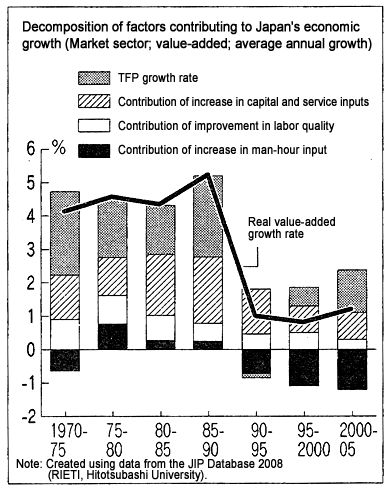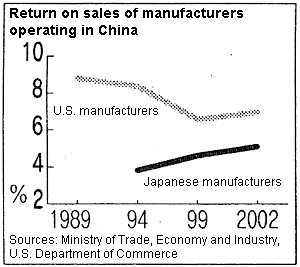Key points:
- Increase in TFP growth rate a primary factor behind growth recovery
- From 0.2% in the 1990s to 1.3% in 2000-2005
- Restructuring-driven TFP growth is problematic
In the recovery phase of the past few years, to what degree has Japan's productivity growth rate increased and how much are Japanese companies trailing their foreign counterparts?
A Japan Center for Economic Research (JCER) study group I headed on the productivity and organizational capital of companies in Japan, China, South Korea, and Taiwan, measured the total factor productivity (TFP, which indicates the degree of improvement in production technology and efficiency, etc.) levels of all listed companies in these four economies and conducted an international comparison of corporate investment in intangible assets (expenditure for research and development, organizational reforms, employee education and training, and other purposes that would result in future production and increased profits). In this article I will provide an analysis of trends in Japan's productivity up to 2005 based on findings from that research. In doing so, I will also refer to two recently released sets of data; the 2008 edition of the Japan Industry Productivity (JIP) Database, a project in which I also am involved, and the March 2008 edition of the EU-KLEMS Database, which was compiled by a European Union project to which the JIP Database provided data on Japan.
* * *
Viewed from the supply side, the real growth rate of the economy can be decomposed into three contributing factors: 1) increases in labor input, 2) increases in capital input, and 3) increases in TFP. In the chart below, labor input is further decomposed into man-hours (total hours of labor input = number of employees multiplied by the number of working hours) and the quality of labor (education level, skills, etc.). Because it is difficult to measure the TFP of the government and non-profit sectors, I focus on TFP growth in the market sector of the economy.
Real growth in the market sector of the economy has increased from an average of 0.9% in the 1990s to 1.2% in 2000-2005. The primary factor behind this is the acceleration of TFP growth (from 0.2% to 1.3%). All the other three growth sources - man-hours, quality of labor, and capital - have been on a down note, depressing the economic growth rate in the 2000s respectively by 0.3%, 0.2%, and 0.3% compared to the 1990s. According to the EU-KLEMS, Japan's TFP growth (in the market sector) in 2000-2005 exceeded the 0.2% average growth of the 15 major member states of the European Union but trailed the 2.0% growth in the United States.
When an economy is in recovery, the operating rates of existing but underutilized production factors (labor and capital) increase, and production tends to expand even with no significant inputs of new production factors. Therefore, the TFP growth rate, obtained as a residual by subtracting the portion attributable to an increase in production factor inputs from real economic growth, is prone to overestimation. In 2000-2005, however, production expanded only moderately and the capital utilization rate increase was insignificant in terms of its impact on the entire market sector of the economy. Thus, as far as this particular period is concerned, the acceleration of TFP growth was quite likely brought about by improved production technology and efficiency.
* * *
A closer look at patterns of TFP growth by industry shows that the array of industries with positive growth, which in the 1990s was limited to information technology (IT)-related manufacturing sectors (electronic equipment and electric measuring instruments, telecommunications, etc.) and wholesale, expanded dramatically from 2000 to include a wide range of non-manufacturing sectors, such as the construction, financial, real estate, road transportation, and lease industries.
TFP growth patterns substantially differ between the non-manufacturing sector, for which average annual growth increased from a negative 0.2% in the 1990s to a positive 1.3% in the 2000s, and the manufacturing sector, where TFP growth remained largely unchanged since the 1990s at the 1.3% level. TFP growth in the non-manufacturing sector increased from 2000 while input of all other growth sources - man-hours, capital, and intermediate inputs of goods and services - receded. The quality of labor barely improved either, as illustrated by continued heavy reliance on part-time workers.
This pattern of TFP growth observed in the non-manufacturing sector can be termed as "restructuring-driven TFP growth," underscoring the fact that companies succeeded in decreasing production factor inputs without reducing output. This can be confirmed by the East Asian Listed Companies Database (EALC; http://www.jcer.or.jp/report/asia/detail3735.html) developed jointly by the JCER, Hitotsubashi University, Nihon University, and Seoul National University. In the non-manufacturing sector, companies that successfully improved TFP also reduced labor and capital input more quickly and significantly than other companies.
In the manufacturing sector, though the input of man-hours dropped more sharply than in the non-manufacturing sector, input of intermediate goods and services and capital input have recently been growing more rapidly than in the latter half of the 1990s, and there has been noticeable particularly from 2001. The quality of labor has also somewhat improved, as reflected in the decreasing reliance on part-time workers. These positive developments can be understood as improvement in production efficiency resulting from globalization, particularly from the development of cross-border production networks in Asia. That is, the improved productivity of Japanese manufacturers is likely to be the result of a process in which capital-intensive and high-skilled labor-intensive production activities are being concentrated in Japan while low-skilled labor-intensive production activities are being transferred to other Asian countries.

According to the Japanese government, the level of Japan's labor productivity remains the lowest among the Group of Seven (G7) major industrial countries. Actually, it has been difficult to perform a detailed analysis of recent productivity developments using accurate data. This is because the previous version of the JIP Database (JIP 2006) covered only the period up to 2002, and though the previous version of the EU-KLEMS Database included comprehensive data for the EU countries through 2004, the data for Japan for the period 2002-2004 were only a simple extrapolation of the JIP 2006 data. However, updating the JIP and EU-KLEMS substantially eliminated these problems and this report is the first full-fledged analysis of the post-recovery productivity trend of Japan.
Although TFP growth in and of itself is highly desirable, it should be of concern if such growth is driven by restructuring, that is, if TFP is growing while growth in all other factors - man-hour input, labor quality, and capital input - is either negative or slowing. As the Japanese population is decreasing, a contraction of man-hour input is inevitable. But, I hope, the government will take appropriate measures to enhance the quality of labor and encourage capital investment.
For instance, as mentioned, the reliance of the non-manufacturing sector on part-time workers has decreased little. A recent research project in which I participated found that not only are part-time workers paid extremely low wages but their contribution to productivity is also low, implying that the formation and accumulation of skills and expertise through means such as on-the-job training may have been impeded. In the 1990s, while the number of workers in low-wage industries such as agriculture and retail decreased primarily by way of retirement, employment expanded in IT-related industries as well as in legal and accounting services, which boosted Japan's growth rate by about 0.2%. This growth-promoting effect of inter-industry labor mobility has disappeared in the 2000s.
The acceleration of TFP growth in the U.S. from 1995 is said to have been supported by investment in intangible assets as well as by non-manufacturers' robust IT investments. In Japan, these types of investments have remained stagnant since 2000. According to the EU-KLEMS Project, in 2000-2005, the contribution of IT capital deepening to growth in the retail sector (commerce and transportation), where the impact of IT investment is thought to be large, was 0.7 percentage points in the U.S. and 0.3 percentage points in the 15 member states of the EU, but only 0.1 percentage points in Japan. Likewise, intangible asset investment accounted for only 10% of gross domestic product (GDP) in Japan (2000-2004 average; based on joint research with Professor Tsutomu Miyagawa of Gakushuin University and other scholars) compared to 14% in the U.S. (2000-2003 average).
* * *
In addition to that discussed above, various other challenges been identified in the course of JCER study group's analysis. Although Japanese manufacturers are generally outperforming their Chinese and South Korean counterparts in terms of TFP, the TFP level of South Korean manufacturers, particularly machinery companies, is surging strongly. In the areas of general and electric machinery, quite a few South Korean companies exhibit TFP that is markedly higher than the average TFP level of Japanese companies. The TFP of Taiwanese manufacturers, particularly in the electric appliances industry, has also been trending significantly upward since 2001.
The Japanese non-manufacturing sector has also been found to be lagging significantly behind overseas non-manufacturers in internationalizing transactions. Since the latter half of the 1990s, many developed countries have expanded imports and exports of computer and information services and other business services, but Japan has shown only a very small increase in such imports and exports. Also, domestic production of such services has been expanding at an extremely slow pace in Japan, compared to that observed in the U.S. It is not yet possible to clearly identify a cause-and-effect relationship between this delayed pace of internationalization in the Japanese service sector and the growth of domestic production and/or improvement of productivity. However, both the promotion of competition through internationalization and the introduction of new technologies and knowhow might fairly be labeled as insufficient in the Japanese service sector.
From 2000, TFP growth has accelerated in Japan as cost-cutting efforts undertaken by companies, particularly those in the non-manufacturing sector, began to pay off. Yet, Japan's TFP growth rate remains far too low compared to the rapid growth achieved in the U.S. during the same period. It should be also noted that restructuring-driven productivity growth has the side effects of hindering labor quality improvement and discouraging capital investment. Japanese companies have been said to possess a long-range perspective. However, the latest findings from growth accounting analyses paint Japan as a country that focuses greatly on cost reduction and lags far behind other developed countries in investment in intangible assets, including employee training and education, and in IT investment. Japan would be wise to further speed TFP growth by promoting investment in these areas.

* Translated by RIETI.
May 9, 2008 Nihon Keizai Shimbun


